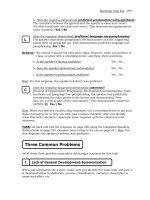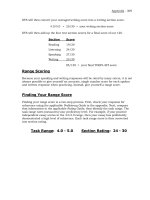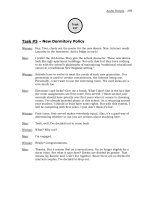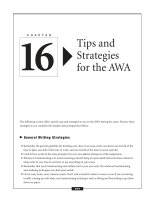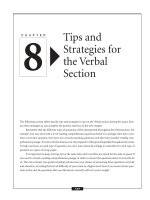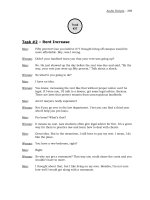Tips and Strategies for the Verbal Section
Bạn đang xem bản rút gọn của tài liệu. Xem và tải ngay bản đầy đủ của tài liệu tại đây (124.1 KB, 18 trang )
The following section offers specific tips and strategies to use on the Verbal section during the exam. Prac-
tice these strategies as you complete the practice exercises in the next chapter.
Remember that the different types of questions will be interspersed throughout the Verbal section. For
example, you may start with a set of reading comprehension questions based on a passage, then have a sen-
tence correction question, then have two critical reasoning questions, and then have another reading com-
prehension passage. Try not to let this distract you. Be prepared to shift gears frequently throughout the exam.
To help you focus on each type of question, jot a few notes about key things to remember for each type of
question on a piece of scrap paper.
It is important to keep moving, but at the same time, don’t sacrifice too much for the sake of speed. If
you need to reread a reading comprehension passage in order to answer the questions about it correctly, do
so. The extra minute you spend rereading will increase your chance of answering those questions correctly
and, therefore, of setting the level of difficulty of your exam at a higher level. Even if you answer fewer ques-
tions in the end, the questions that you did answer correctly will carry more weight.
CHAPTER
Tips and
Strategies for
the Verbal
Section
8
137
The First Five Questions
Remember that on this CAT your answers to the first five questions in each category will largely determine the
level of difficulty of your exam. Take some extra time to make sure you answer these questions correctly.
138
Reading Comprehension Questions
Smart Approach
Remember that active reading is your best strategy for comprehension. On the exam, read each passage three
times:
1. First, preview. Scan the passage quickly to get a general sense of the argument and context. This
should take less than a minute. Use your finger to guide you down the screen so your eyes keep mov-
ing. Do not slip into reading mode if a word or sentence catches your attention. Keep skimming.
2. Second, read carefully and actively. Use your scratch paper to take notes about main ideas, connec-
tions within the text, key terms, and support. As you read, try to outline the passage.
3. Third, review the passage. Scan it again to get a better sense of the whole: the whole argument and the
overall organization of the text. This review will also help you better understand key ideas and terms.
You can preview the question stem if you like, but don’t try to memorize it. More important, don’t waste
time reading the question options before you read the passage. Four of the five are incorrect, and the distracters
may actually confuse you as you read.
Other Tips
■
Most questions will be about key ideas and issues in a passage, not about minor details. Don’t focus on
trying to remember specific facts or details as you read. If you outline the passage as you read, you
should know where to find specific details if you happen to get such a question.
■
Remember that your notes are for your use only. They don’t have to be neat, and they don’t have to
make sense to anyone else except you. Use whatever shorthand or note-taking method you feel com-
fortable with.
■
Read all options carefully. Several of the options may state information that is true based on the pas-
sage, but those statements may not answer the question or may not be the best answer to the question.
Beware of distracters that are true statements drawn from other parts of the text. Because they look
familiar, they may seem like the correct answer, but they may not provide the best answer to the
question.
■
Base your answers only on the information provided in the passage. Don’t answer based upon your own
reactions, ideas, or knowledge.
139
■
Refer to the passage as often as you need to; reread sections or the entire passage if you have to. It is
better to take the time to understand a passage so you can answer the questions correctly than to just
guess so you can move on to the next passage or question. Remember, the more correct answers you
provide at the beginning of the test, the higher the level the CAT will establish for you and the better
your potential for a higher score.
■
Context clues can help you determine the meaning of unfamiliar words. At a minimum, try to deter-
mine whether the unfamiliar word is something positive or negative.
■
In a long text, the main idea (if stated) is often located in the first paragraph. Within one paragraph,
the main idea (if stated in a topic sentence) is often the first sentence in that paragraph.
■
Remember that the main idea must be general enough to encompass (hold together) all of the ideas in
the passage.
■
Remember to distinguish between facts (things known to be true) and opinions (things believed to
be true).
■
Use key words and the structure of the passage to locate specific facts and details.
■
Remember that a writer’s purpose drives every decision a writer makes, including how to organize the
text. The overall organizing principle of a passage will reflect the writer’s purpose.
■
Watch for transitions that suggest the organizational pattern and show the relationships between ideas.
■
Make sure your inferences are logical and based only on the evidence in the text. If you cannot point to
evidence in the text itself, your inference may not be valid.
■
Look carefully at word choice for clues to the writer’s feelings.
Critical Reasoning Questions
Smart Approach
Critical reasoning passages are short, but you need to read the passages very carefully to answer the questions
correctly:
1. First, skim through each passage. Then reread the passage at a slow, careful pace.
2. Read the question stem. This will tell you what sort of argument you are dealing with. For example,
say the stem asks “Which of the following conclusions can be drawn from the previous passage?” You
know you do not need to spend any time searching the passage for the conclusion of the argument.
Rather, the question is asking you to pick the best conclusion offered through inference.
Use Scrap Paper
Use as much scrap paper as you need for notes, outlines, and calculations—whatever you need to do to help
you determine the correct answer. If you run out of scrap paper, you can always ask for more.
Educated Guessing
If you need to guess, make sure it’s an educated guess. You should be able to eliminate at least one or two
answer choices.
140
3. Use the question stem as your guide to identify the elements of the argument. For example, if the stem
asks about a flaw in the argument, search for a fallacy; if the stem asks about assumptions upon which
the argument is based, try to identify in your mind what assumption(s) would make the argument
valid. It helps to do this before reading the answer choices because the wording of the choices can be
confusing. This way, you will know what you are looking for when you read the options.
4. Read each answer choice carefully. Which one seems to best provide you with the correct answer?
Other Tips
■
Remember that an argument must have a premise and a conclusion, but the premise or conclusion may
be unstated.
■
If the premise is missing, ask yourself if any assumptions must be true in order for the argument to be
valid. Find the missing link between premise and conclusion.
■
Remember that a premise for one conclusion can be the conclusion of another argument.
■
Conclusions must be based on the evidence in the passage. If an answer choice does not have relevant
evidence, it cannot be the correct answer.
■
Do not let your opinion on the matter influence your answer selection. Stick to the statements and
claims in the argument that has been presented.
■
Pay extra attention to the question stem. Make sure you are looking for the right kind of answer.
Remember, many questions will ask you for the exception.
■
You do not need to name the fallacy
—
you just need to be able to recognize that something is wrong
with the argument. Do not worry about classifying the flaw; just identify the problem with the argu-
ment’s logic.
■
Remember that qualifiers strengthen arguments by limiting their scope. For example, stating that “most
students would benefit from more individualized instruction” is a more accurate (and therefore
stronger) statement than “all students would benefit from more individualized instruction.”
■
Keep in mind the four characteristics of good evidence: sufficient, relevant, unbiased, and logical.
■
Whenever an argument makes a comparison, check to see if it is an apples-to-oranges comparison.
■
Whenever an argument asks you to reject a claim, check to see if it is an ad hominem argument (reject-
ing a claim because of who makes the claim, not because of the merits of the claim).
■
Watch for arguments that bring in irrelevant issues (red herrings). Premises must be directly related to
their conclusions to be logical.
■
Whenever a passage offers an explanation, make sure it is a good one: testable, noncircular, precise, reli-
able, relevant, consistent with established theories, and convincing.
■
Whenever you are presented with a causal argument, check for the fallacies of causal reasoning: post
hoc, reversing causation, ignoring a common cause, and assuming a common cause.
Sentence Correction Questions
Smart Approach
With sentence correction questions, it can be time consuming to read each answer choice to determine which
one is best. Use the following steps instead:
1. Reread the original version carefully and listen to the sentence in your head. Make sure you hear how it
sounds; this will often help you identify the error. Even if you do not know the grammar rule or can-
not name the grammatical or stylistic problem, you can often tell if something is wrong.
2. Identify the error(s) that is made in that sentence. Is it grammatical or stylistic?
3. Quickly scan the other versions to rule out sentences that make the same mistake.
4. Of the versions that remain, which one most effectively corrects the sentence?
5. Make sure the versions that correct the original error do not insert additional errors.
Seven-Step Checklist
1. Check sentence basics. Locate the subject(s) and verb(s). Is the sentence complete? Are verbs properly
formed? Are sentence elements in the proper order (subject, verb, indirect object, and object)?
2. Check for agreement. Do the subject(s) and verb(s) agree? Do pronouns agree with their antecedents?
3. Check for consistency. Are verbs consistent in tense? Is pronoun use consistent?
4. Check for structure. Are items parallel? Are modifiers as close as possible to what they modify?
5. Check for clarity. Are words precise? Are ideas direct (expressed in the active voice, with subject first
and then verb)?
6. Check for concision. Are unnecessary words crowding the sentence? Is anything repeated
unnecessarily?
7. Check for style. Are idioms used correctly? Does anything else just sound wrong?
Other Tips
■
Remember, don’t worry about vocabulary or mechanics (spelling, punctuation, and capitalization).
These kinds of errors are not tested on the exam. If you think that a sentence has one of these errors,
ignore it and look for another mistake in the sentence.
■
Don’t bother reading choice a on sentence correction questions. It repeats the original version, giving
you a correct as is choice.
■
Remember that some of the original sentences will be correct as is. If you read the sentence and it
sounds correct, a might be the right answer. If you suspect this is the case, quickly scan choices b
through e to see if any other version expresses the idea more effectively.
–
TIPS AND STRATEGIES FOR THE VERBAL SECTION
–
141
■
Focus only on the underlined portion because that’s where the error lies. Don’t get caught up trying to
understand the whole sentence, especially if it is long, if only a portion of that sentence is underlined.
■
Be wary of long versions. The longer versions are often (but not always) ineffective; they may be redun-
dant, wordy, or poorly constructed.
■
Look for words that signal relationships and make connections: subordinating conjunctions, coordi-
nating conjunctions, and conjunctive adverbs. These words help describe the relationship between
ideas and determine sentence boundaries and punctuation.
■
Incorrect idioms are among the most common errors on the GMAT exam. Be sure not to skip over
small words such as prepositions (to,for,in,of...) as you read.Prepositions are particularly important
in idioms, and if you read too quickly, you might not pick up an idiomatic error.
–
TIPS AND STRATEGIES FOR THE VERBAL SECTION
–
142
Verbs are the heart of a sentence. They express the action or state of being of the subject and indicate what
the subject is doing, thinking, or feeling:
She y
elled out the window. (action)
I am
happy to be here. (state of being)
We f
eel very lucky to be alive. (state of being)
I sho
uld ask Winston what he thinks. (action)
Verbs have five basic forms: infinitive, present tense, present participle, past tense, and past participle.
These five forms are used with other helping verbs to form other verb tenses, including the future, conditional,
and subjunctive mood (see pages 150
—
151).
■
Infinitive base: the base form of the verb plus the word to.
to go to be to dream to admire
CHAPTER
Ver b Forms
9
143
